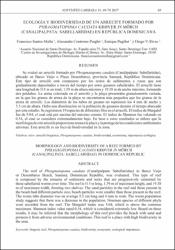| License | Creative Commons Atribución-NoComercial 4.0. | es |
| Author | Santos-Mella, Francisco | |
| Author | Contreras Puigbó, Alexandra | |
| Author | Pugibet Bobea, Enrique | |
| Author | Rivas, Diego V. | |
| Accessioned date | 2022-01-02T16:09:17Z | |
| Available date | 2022-01-02T16:09:17Z | |
| Year | 2017 | |
| Citation | Santos-Mella, F., Contreras-Puigbó, A., Pugibet, E. y Rivas, D. V. (2017). Ecología y biodiversidad de un arrecife formado por Phragmatopoma caudata Krøyer in Mörch (Canalipalpata: Sabellariidae) en República Dominicana. Novitates Caribaea, (11), 69–78. Recuperado de: https://doi.org/10.33800/nc.v0i11.16 | es |
| URI | https://bvearmb.do/handle/123456789/439 | |
| Abstract | [Español] Se evaluó un arrecife formado por Phragmatopoma caudata (Canalipalpata: Sabellariidae), ubicado en Barco Viejo o Playa Desembarco, provincia Samaná, República Dominicana. Este tipo de arrecife está compuesto por los restos de sedimentos y rocas que son gradualmente depositados a través del tiempo por estos gusanos sabeláridos. El arrecife tiene una longitud de 115 m en total, 1.59 m de altura máxima y 19.58 m de ancho máximo, formando dos peldaños. La arena colectada en el arrecife y la playa presentaba granulometría variada, en la que los granos de arena de la playa se encontraron más pequeños que los granos de la arena de arrecife. Los diámetros de los tubos de gusano no superaron los 4 mm de ancho y 5.5 cm de altura. Hubo una disminución en la población de gusanos durante el tiempo abarcado por este estudio. Se registraron 19 especies de diferentes filos en el arrecife. El índice de Margalef fue de 5.04, el cual está por encima del máximo común. El índice de Shannon fue valorado en 0.54, el cual se considera extremadamente bajo. En base a estos resultados se infiere que la morfología de este arrecife proporciona arena a la playa y la protege de las condiciones ambientales adversas. Este arrecife es un foco de biodiversidad en la zona. | es |
| Abstract | [English] The reef of Phragmatopoma caudata (Canalipalpata: Sabellariidae) in Barco Viejo or Desembarco Beach, Samaná, Dominican Republic, was evaluated. This type of reef is composed by the remains of sediments and rocks that are progressively cemented by these sabellariid worms over time. The reef is 115 m long, 1.59 m of maximum height, and 19.58 m of maximum width, forming two shelves. The sand particles in the reef and those present in the beach had different particle size; beach particles were smaller than those present in the reef. The worm tube diameter was on average 5.5 cm long and 4 mm in wide. The worm population study suggests that there was a decrease in the population. Nineteen species of different phyla were recorded from the reef. The Margalef index was 5.04, which is above the common maximum. Shannon index value rated 0.54, which is considered extremely low. Based on these results, it may be inferredthat the morphology of this reef provides the beach with sand and protects it from adverse environmental conditions. This reef is a place with high biodiversity in the area. | en |
| Language | Spanish | es |
| Published | Novitates Caribaea [ISSN: 2079-0139], (11), 69–78. | es |
| Rights | © Novitates Caribaea. Todos los derechos reservados, 2017. | es |
| Rights URI | https://creativecommons.org/licenses/by-nc/4.0/ | es |
| Subject | Biodiversidad - República Dominicana | es |
| Subject | Hábitats y especies | es |
| Title | Ecología y biodiversidad de un arrecife formado por Phragmatopoma caudata Krøyer in Mörch (Canalipalpata: Sabellariidae) en República Dominicana | es |
| dc.title.alternative | Morphology and biodiversity of a reef formed by Phragmatopoma caudata Krøyer in Mörch (Canalipalpata: Sabellariidae) in Dominican Republic | en |
| dc.identifier.doi | 10.33800/nc.v0i11.16. | |
| Material type | Article | es |
| Type of content | Scientific research | es |
| Access | Open | es |
| Audience | Technicians, professionals and scientists | es |


